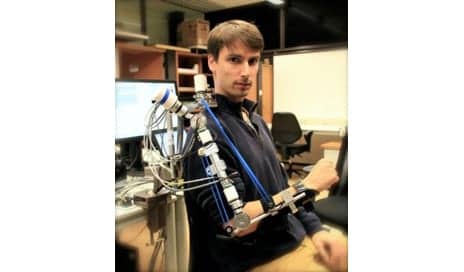Called the A-Gear, the robotic arm is designed to help support independent operation of the arm in patients with Duchenne muscular dystrophy.
The robotic arm, which can be worn discreetly under clothing, was developed by researchers from the University of Twente’s MIRA research centre, together with the VUmc, TU Delft and the Radboud umc.
Over the past 4 years, the researchers have been working on two arm supports: a passive arm support—controlled by the user, without motors—and an active arm support—powered by motors that are controlled by the user. The active arm support is controlled by electrical (EMG) muscle signals or minimum muscle strength from the arm, which makes movement as intuitive and natural as possible, explains a media release from University of Twente.
Researchers at the MIRA research centre for Biomedical Technology and Technical Medicine compared the arm functionality of boys with Duchenne muscular dystrophy with and without support from the robotic arm, according to the release.
“During the research, there were a number of participants who had been unable to independently move their arms for between 3 and 5 years, and they were able to complete the tests set out in the tasks. The freedom of movement and the functionality of the arm increased when the subjects used the prototype. In addition, the movements required less energy,” states researcher Joan Lobo-Prat.
During the design assessment, the researchers also looked at data from the Duchenne Dynamic Arm Study to obtain more insight into the development of arm function in men and boys with the disease.
By measuring the arm function of patients of different ages, they were able to obtain an impression of how the arm function changes over the course of the illness and accordingly, how to adjust the arm support over time, the release explains.
Work is continuing to develop the A-Gear prototype into a product that can be used effectively, per the release.
[Source(s): University of Twente, Science Daily]





